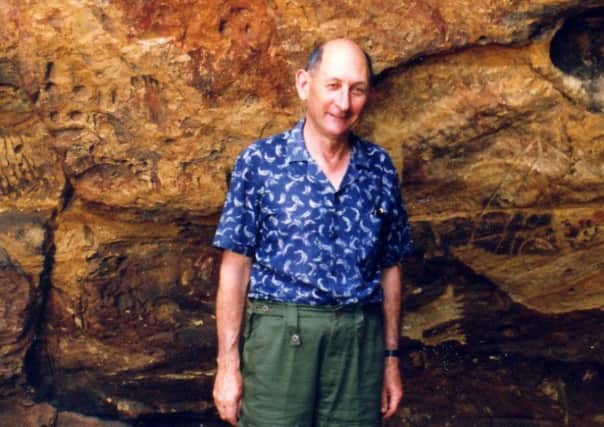Obituary: John Mulvaney, archaeologist


Archaeologist John Mulvaney revolutionised the way Australia thought about itself by proving that the Aborigines had been there since the Ice Age. The method he used was radio-carbon dating, still a new technique in the 1950s when he first explored rock shelters and sacred sites in Queensland and Victoria.
Even he, then a young lecturer in ancient history at Melbourne University, doing digs in his spare time, was surprised when in 1962 analysis showed some of his finds of charcoal at Kenniff Caves, Queensland, to be 16,000 years old, from the epoch known as the Pleistocene. Later discoveries proved to be 32,000 years old, and some go back as much as 60,000 years – a time when mammoths roamed the earth.
Advertisement
Hide AdAdvertisement
Hide AdIt was the cue for Mulvaney to end what has been called “the great Australian silence”, with a wealth of evidence to put paid to popular ideas that the Aborigines had been there for only a few centuries before the First Fleet arrived in 1788.
Mulvaney, then Australia’s only university-trained archaeologist, was the man best qualified to lead the campaign to recognise the Aborigines as – in his words – “the discoverers, explorers and colonists of Australia”, something that reduced European history’s two centuries there to, as he put it, “a few minutes on the clock face of time”.
Having established a body of archaeological fieldwork in Australia, he could now move on from teaching his students about Greece and Rome, to showing them the fascinating palaeontology of their own country. A wealth of exciting finds followed, from rock art to tools, human remains such as the 42,000-year-old ritually buried “Mungo lady” from Lake Mungo in the Willandra Lakes region in New South Wales.
Mulvaney meticulously respected the strata in which items were discovered, excavating so carefully that he sometimes used teaspoons.
His patience among the remote sites he explored sprang from the same determination that had led him, as a history graduate of Melbourne University in 1953, to seek out the skills he needed to be an archaeologist – then not offered anywhere in Australia – by doing an undergraduate course in the subject in Britain.
Offered a scholarship from Melbourne University to study for a doctorate, he instead asked to do undergraduate Archaeology and Anthropology at Clare College, Cambridge, to acquire basic techniques. He went on to do a PhD there, also participating in a dig with the celebrated archaeologist Charles McBurney at Haua Fteah, Libya, and making friends among developers of the science of radiocarbon dating, invented in 1949.
Mulvaney wrote many scholarly articles and 17 books. These included The Prehistory of Australia (1969) and his autobiography, Digging Up a Past (2011).
He joined Australian National University in Canberra in 1965, where he was Professor of Prehistory. His scholarship led him to take up many public causes, and he became known as “the father of Australian archaeology”.
Advertisement
Hide AdAdvertisement
Hide AdA modest and genial man, beloved of his students, he brought Aborigine representatives into the discussion of Australia’s past – but did not flinch from taking a stand on matters he felt were important.
One was the Kow Swamp controversy, in which present-day Aborigine residents wanted ancient artefacts that had been found at the site in south-eastern Australia re-buried there, and lost to scholarship. Mulvaney argued for a special “keeping place” where they could continue to be observed – but the reburial went ahead, in 1991. He called this “my career’s most distressing episode”.
Earlier he had taken up environmental issues, joining opponents of a plan for a hydroelectric dam on the Gordon and Franklin rivers in Tasmania, who argued that it would damage the Franklin river’s fragile ecosystem.
The debate contributed to the fall of the Liberal government of Malcolm Fraser in 1983, and Mulvaney became an adviser to the incoming Australian Labor Party administration of Bob Hawke, which after fighting a court case succeeded in getting the plan cancelled.
As a boy Mulvaney, one of five siblings, was inspired by adventure tales told around the kerosene lamp in his family’s red-brick house at Alberton, Victoria, south Australia.
The young Mulvaney loved reading Stories of Australian Exploration by Charles R Long, and remembered meeting the author – who died in 1944 – when Long visited his secondary school, Frankston High School, in Victoria.
Having left school in December 1941, Mulvaney worked as a teacher before piloting Avro Ansons in the Royal Australian Air Force.
While at Clare College he met Jean Campbell, who was representing the Girl Guides of Victoria at the Queen’s coronation in 1953. They married in 1954, and would have six surviving children, Clare, Anne, Kenneth, Richard, Gregory and Michael.
Advertisement
Hide AdAdvertisement
Hide AdJean died in 2004 and in 2006 Mulvaney wed Elizabeth Morrison, who also survives him.
Mulvaney was appointed CMG in 1982. He was a Fellow of the Australian Academy of the Humanities, a Commissioner of the Australian Heritage Commission, and a Fellow of the Order of Australia.
anne keleney